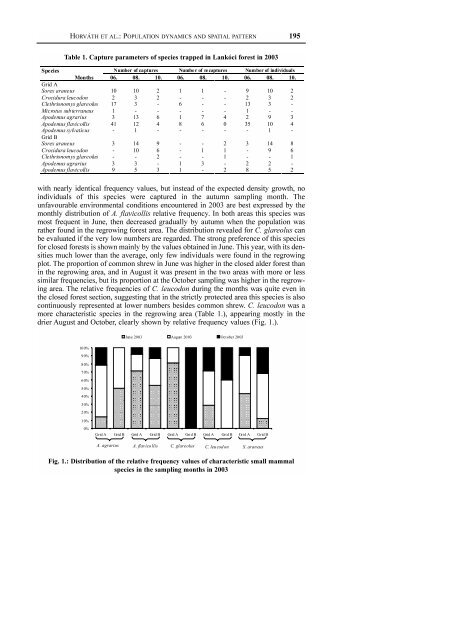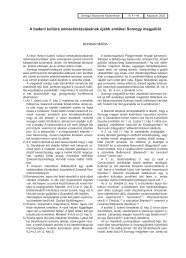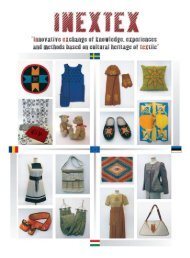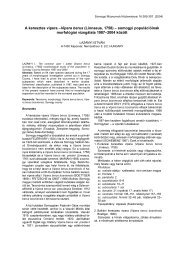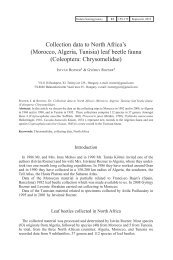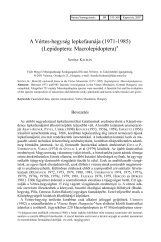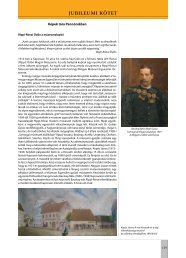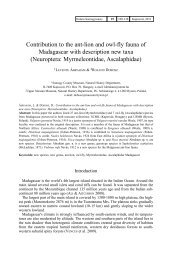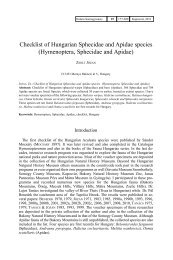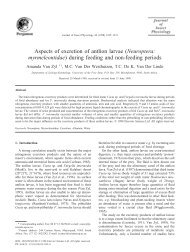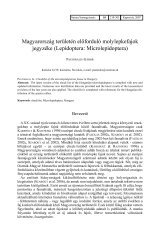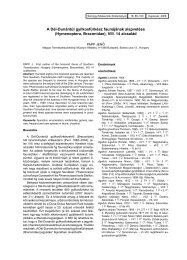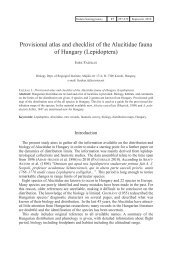Population dynamics and spatial pattern of small mammals in ...
Population dynamics and spatial pattern of small mammals in ...
Population dynamics and spatial pattern of small mammals in ...
Create successful ePaper yourself
Turn your PDF publications into a flip-book with our unique Google optimized e-Paper software.
HORVÁTH ET AL.: POPULATIONDYNAMICS AND SPATIAL PATTERN<br />
195<br />
Table 1. Capture parameters <strong>of</strong> species trapped <strong>in</strong> Lankóci forest <strong>in</strong> 2003<br />
with nearly identical frequency values, but <strong>in</strong>stead <strong>of</strong> the expected density growth, no<br />
<strong>in</strong>dividuals <strong>of</strong> this species were captured <strong>in</strong> the autumn sampl<strong>in</strong>g month. The<br />
unfavourable environmental conditions encountered <strong>in</strong> 2003 are best expressed by the<br />
monthly distribution <strong>of</strong> A. flavicollis relative frequency. In both areas this species was<br />
most frequent <strong>in</strong> June, then decreased gradually by autumn when the population was<br />
rather found <strong>in</strong> the regrow<strong>in</strong>g forest area. The distribution revealed for C. glareolus can<br />
be evaluated if the very low numbers are regarded. The strong preference <strong>of</strong> this species<br />
for closed forests is shown ma<strong>in</strong>ly by the values obta<strong>in</strong>ed <strong>in</strong> June. This year, with its densities<br />
much lower than the average, only few <strong>in</strong>dividuals were found <strong>in</strong> the regrow<strong>in</strong>g<br />
plot. The proportion <strong>of</strong> common shrew <strong>in</strong> June was higher <strong>in</strong> the closed alder forest than<br />
<strong>in</strong> the regrow<strong>in</strong>g area, <strong>and</strong> <strong>in</strong> August it was present <strong>in</strong> the two areas with more or less<br />
similar frequencies, but its proportion at the October sampl<strong>in</strong>g was higher <strong>in</strong> the regrow<strong>in</strong>g<br />
area. The relative frequencies <strong>of</strong> C. leucodon dur<strong>in</strong>g the months was quite even <strong>in</strong><br />
the closed forest section, suggest<strong>in</strong>g that <strong>in</strong> the strictly protected area this species is also<br />
cont<strong>in</strong>uously represented at lower numbers besides common shrew. C. leucodon was a<br />
more characteristic species <strong>in</strong> the regrow<strong>in</strong>g area (Table 1.), appear<strong>in</strong>g mostly <strong>in</strong> the<br />
drier August <strong>and</strong> October, clearly shown by relative frequency values (Fig. 1.).<br />
Fig. 1.: Distribution <strong>of</strong> the relative frequency values <strong>of</strong> characteristic <strong>small</strong> mammal<br />
species <strong>in</strong> the sampl<strong>in</strong>g months <strong>in</strong> 2003


